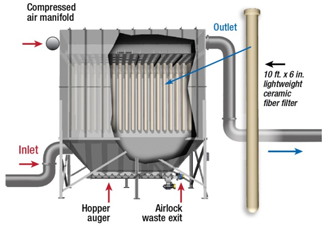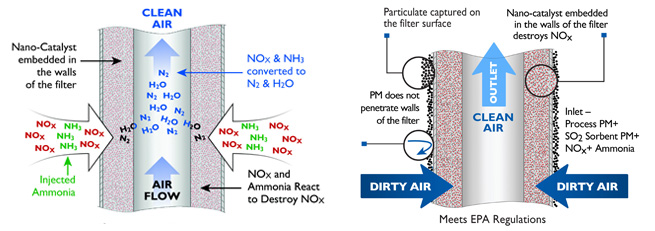
 Downloads
DownloadsTri-Mer catalytic ceramic filters use glass emissions filter technology with nano-bits of SCR catalyst embedded in the walls.
Filters are placed in housings and operate similarly to a “reverse pulse jet ceramic baghouse.” The filters are 10' long and 6" wide, with a wall thickness of approximately ¾ inch. Learn more information about Tri-Mer&rsquos;s hot gas filtration.
The micronized catalyst offers a larger surface area for reaction than conventional SCR, with virtually no diffusion restriction.

The catalyst particles are micro-porous, and due to their small size, they catalyze the gas phase reactions without diffusion and restriction (i.e. almost 100% utilization of the catalyst intrinsic activity) as opposed to usual pellet or monolithic catalysts. In industrial plants, the conventional catalyst types typically operate with 5-15% catalyst effectiveness in the SCR (Selective Catalytic Reduction of NOx by NH3).

All catalysts can be severely compromised by particulate blinding of the surface, chemical interactions on the surface with particulate, and gas phase poisons. With the catalytic filter system, particulate is captured on the filter surface.
The nano-catalyst is almost completely protected inside the filter, virtually eliminating particulate-type interactions and extending catalyst life.
Regarding gas phase, the proprietary catalyst formulation is engineered for extremely low conversion of SO2 to SO3 (less than 10% of some competing catalysts) and is immune to HCl.
Developments in ceramic filter technology offer the industry a powerful, proven strategy for meeting regulatory requirements for glass furnace emissions.
• Particulate (PM 10, PM 2.5, PM 1.0) • NOx • SOx (SO2, SO3) • HCl, HF • Metals (Selenium, Arsenic …) • Mercury • Hexavalent Chrome • Dioxins / Furans • Selective VOC (Cement O-HAPS) • Add-on CO module available